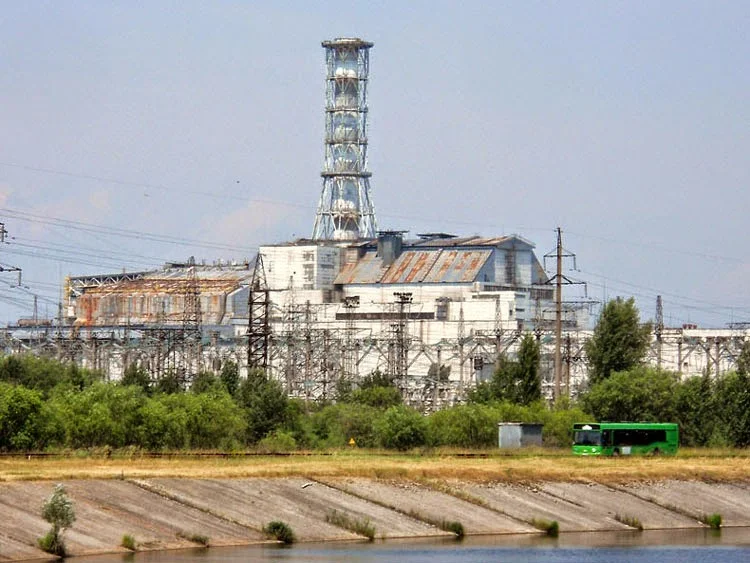

 The Chernobyl disaster was a catastrophic nuclear accident that occurred on 26 April 1986 at the Chernobyl Nuclear Power Plant in Ukraine, which was under the direct jurisdiction of the central authorities of the Soviet Union. An explosion and fire released large quantities of radioactive particles into the atmosphere, which spread over much of the western USSR and Europe. The Chernobyl disaster is the worst nuclear power plant accident in history in terms of cost and resulting deaths, and is one of only two classified as a level 7 event on the International Nuclear Event Scale. The battle to contain the contamination and avert a greater catastrophe ultimately involved over 500,000 workers and cost an estimated 18 billion rubles. During the accident itself 31 people died, and long-term effects such as cancers and deformities are still being accounted for.
The Chernobyl disaster was a catastrophic nuclear accident that occurred on 26 April 1986 at the Chernobyl Nuclear Power Plant in Ukraine, which was under the direct jurisdiction of the central authorities of the Soviet Union. An explosion and fire released large quantities of radioactive particles into the atmosphere, which spread over much of the western USSR and Europe. The Chernobyl disaster is the worst nuclear power plant accident in history in terms of cost and resulting deaths, and is one of only two classified as a level 7 event on the International Nuclear Event Scale. The battle to contain the contamination and avert a greater catastrophe ultimately involved over 500,000 workers and cost an estimated 18 billion rubles. During the accident itself 31 people died, and long-term effects such as cancers and deformities are still being accounted for.
The disaster
The disaster began during a systems test on Saturday, 26 April 1986 at reactor number four of the Chernobyl plant, which is near the city of Pripyat and in proximity to the administrative border with Belarus and the Dnieper River. There was a sudden and unexpected power surge, and when an emergency shutdown was attempted, an exponentially larger spike in power output occurred, which led to a reactor vessel rupture and a series of steam explosions. These events exposed the graphite moderator of the reactor to air, causing it to ignite.
The resulting fire sent a plume of highly radioactive fallout into the atmosphere and over an extensive geographical area, including Pripyat. The plume drifted over large parts of the western Soviet Union and Europe. From 1986 to 2000, 350,400 people were evacuated and resettled from the most severely contaminated areas of Belarus, Russia, and Ukraine. According to official post-Soviet data, about 60% of the fallout landed in Belarus.
 |
Soviet Awakened
The accident raised concerns about the safety of the Soviet nuclear power industry, as well as nuclear power in general, slowing its expansion for a number of years and forcing the Soviet government to become less secretive about its procedures. The government cover-up of the Chernobyl disaster was a "catalyst" for glasnost, which "paved the way for reforms leading to the Soviet collapse".
Russia, Ukraine, and Belarus have been burdened with the continuing and substantial decontamination and health care costs of the Chernobyl accident. A report by the International Atomic Energy Agency examines the environmental consequences of the accident. Another UN agency, UNSCEAR, has estimated a global collective dose of radiation exposure from the accident "equivalent on average to 21 additional days of world exposure to natural background radiation"; individual doses were far higher than the global mean among those most exposed, including 530,000 local recovery workers who averaged an effective dose equivalent to an extra 50 years of typical natural background radiation exposure each.
Number of deaths
Estimates of the number of deaths that will eventually result from the accident vary enormously; disparities reflect both the lack of solid scientific data and the different methodologies used to quantify mortality – whether the discussion is confined to specific geographical areas or extends worldwide, and whether the deaths are immediate, short term, or long term.
 |
| Chernobyl Disaster |
Death Roll
Thirty one deaths are directly attributed to the accident, all among the reactor staff and emergency workers. An UNSCEAR report places the total confirmed deaths from radiation at 64 as of 2008. The Chernobyl Forum predicts the eventual death toll could reach 4000 among those exposed to the highest levels of radiation this figure is a total causal death toll prediction, combining the deaths of approximately 50 emergency workers who died soon after the accident from acute radiation syndrome, nine children who have died of thyroid cancer and a future predicted total of 3940 deaths from radiation-induced cancer and leukemia.
In a peer-reviewed publication in the International Journal of Cancer in 2006 the authors stated, without entering into a discussion on deaths that in terms of total excess cancers attributed to the accident.
The risk projections suggest that by now Chernobyl may have caused about 1000 cases of thyroid cancer and 4000 cases of other cancers in Europe, representing about 0.01% of all incident cancers since the accident. Models predict that by 2065 about 16,000 cases of thyroid cancer and 25,000 cases of other cancers may be expected due to radiation from the accident, whereas several hundred million cancer cases are expected from other causes.
Similar…
postCheck





check comment
ReplyDeleteAnother Check
ReplyDeleteThis is the author comment
ReplyDelete